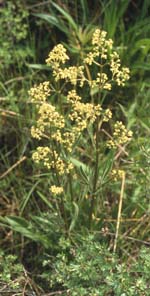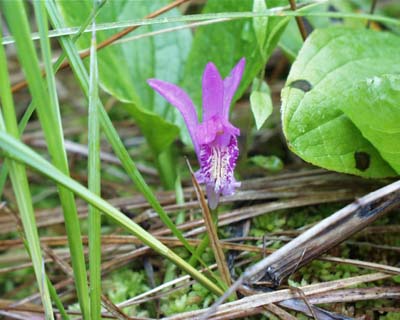
 Rare Plant
Species
Rare Plant
SpeciesAnd
Management Plans
Amy Faivre
 I chose to major in biology while in college in the hopes of spending as
much time outdoors as possible. Students working with me will have
plenty of opportunities to conduct fieldwork in a variety of habitats, as
well as pursue studies in the greenhouse and laboratory. One of my
main interests includes plant reproductive biology and the animals that are
responsible for floral pollination. I have researched hummingbird-pollinated
flowers in the mountains of southern Arizona, as well as, plants in the coffee
family in the rainforests of both Costa Rica and Panama. I have observed
pollen tube growth within several species to determine if these species are
capable of accepting their own pollen to produce seeds, or if they have to
receive pollen from a different plant in order to set seed. Pollen
tubes can be viewed in the laboratory using fluorescence microscopy (see
photo).
I chose to major in biology while in college in the hopes of spending as
much time outdoors as possible. Students working with me will have
plenty of opportunities to conduct fieldwork in a variety of habitats, as
well as pursue studies in the greenhouse and laboratory. One of my
main interests includes plant reproductive biology and the animals that are
responsible for floral pollination. I have researched hummingbird-pollinated
flowers in the mountains of southern Arizona, as well as, plants in the coffee
family in the rainforests of both Costa Rica and Panama. I have observed
pollen tube growth within several species to determine if these species are
capable of accepting their own pollen to produce seeds, or if they have to
receive pollen from a different plant in order to set seed. Pollen
tubes can be viewed in the laboratory using fluorescence microscopy (see
photo). Conservation biology is also one of my major interests, especially after
seeing the extent of habitat loss and fragmentation occurring across the
United States and abroad. While conducting research on a state endangered
plant in Ohio, I compared levels of genetic variation among Ohio and Michigan
populations. This plant, prairie valerian [Valeriana ciliata] (see
photo), is found only in the mid-west in the unique wetland fen habitat.
I have also worked for the Ohio Department of Natural Resources in the Division
of Natural Areas and Preserves (DNAP). Working with DNAP has made me
increasingly aware of the negative impact of non-native, invasive plant species
to natural areas. As part of my job with DNAP, I have been documenting
the extent of non-native, invasive plant species populations in our state
nature preserves using GPS (Global Positioning System), and projecting these
data onto aerial photos using GIS (Geographical Information System) software.
Students working with me will be encouraged to pursue questions related to
endangered plants locally as well as globally, including studies of their
reproductive biology, genetic diversity, and distribution. Both the
extent and quality of the plant species habitats and impacts on these habitats
will be studied and recorded using GPS/GIS. (See the photo of the pink Dragon’s-mouth
Orchid [Arethusa bulbosa], a state-endangered species in Ohio, that requires
extensive habitat management to ensure its continued blooming and reproduction.)
Conservation biology is also one of my major interests, especially after
seeing the extent of habitat loss and fragmentation occurring across the
United States and abroad. While conducting research on a state endangered
plant in Ohio, I compared levels of genetic variation among Ohio and Michigan
populations. This plant, prairie valerian [Valeriana ciliata] (see
photo), is found only in the mid-west in the unique wetland fen habitat.
I have also worked for the Ohio Department of Natural Resources in the Division
of Natural Areas and Preserves (DNAP). Working with DNAP has made me
increasingly aware of the negative impact of non-native, invasive plant species
to natural areas. As part of my job with DNAP, I have been documenting
the extent of non-native, invasive plant species populations in our state
nature preserves using GPS (Global Positioning System), and projecting these
data onto aerial photos using GIS (Geographical Information System) software.
Students working with me will be encouraged to pursue questions related to
endangered plants locally as well as globally, including studies of their
reproductive biology, genetic diversity, and distribution. Both the
extent and quality of the plant species habitats and impacts on these habitats
will be studied and recorded using GPS/GIS. (See the photo of the pink Dragon’s-mouth
Orchid [Arethusa bulbosa], a state-endangered species in Ohio, that requires
extensive habitat management to ensure its continued blooming and reproduction.)